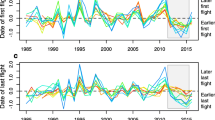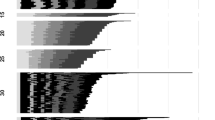Abstract
The prediction of adult emergence times in insect populations can be greatly complicated by microclimatic gradients, especially in circumstances where distributions of juveniles along those gradients vary from year to year. To investigate adult emergence patterns in topographically heterogeneous habitats, we built a model of postdiapause development of the Bay checkerspot butterfly, Euphydryas editha bayensis. The model uses slope-specific insolation as the rate-controlling variable, and accounts for both solar exposure of the habitat and cloud cover. Instar-specific larval mass gains per unit of insolation were determined from mark-recapture experiments. A small correction for daily low temperatures was used to calibrate the model to five years of field data on larval mass. The model predicted mean mass of 90% of larval samples within 4 clear days over a 70–120 day growing season. The magnitude of spatial variation in emergence times across habitat slopes is greater than annual variation in emergence times due to yearly weather conditions. Historical variation (yearly shifts in larval distributions across slopes) is an important determinant of mean population emergence dates. All of these factors need to be considered in understanding adult emergence phenology in this butterfly and in other insects inhabiting heterogeneous thermal environments. Such an understanding can be useful in managing insect populations for both pest control and conservation.
Similar content being viewed by others
References
Allen JC, McCoy CW (1979) The thermal environments of the citrus rust mite. Ag Meteor 20:411–425
Andrewartha HG, Birch LC (1984) The Ecological Web. University of Chicago Press, Chicago III
Baker CRB (1981) Accumulated temperatures in some pest habitats in 1976–78. Ag Meteor 23:245–253
Boyko H (1947) On the role of plants as quantitative climate indicators and the geoecological law of distribution. J Ecol 35:138–157
Bradshaw WE, Holzapfel CM (1990) Evolution of phenology and demography in the pitcher plant mosquito, Wyeomyia smithii. In: Gilbert F (ed.) Insect Life Cycles; Genetics, Evolution, and Coordination. Springer Berlin Heidelberg New York pp 47–68
Caprio JM (1974) The solar thermal unit concept in problems related to plant development and potential evapotranspiration. In: Lieth H (ed) Phenology and seasonality Modeling Ecological studies 8 Springer Berlin Heidelberg New York. pp 353–364
Currey GL, Feldman RM (1987) Mathematical foundations of population dynamics. Texas A&M University Press, College Station, Texas
den Boer PJ (1981) On the survival of populations in a heterogeneous and variable environment. Oecologia 50:39–53
Dobkin DS, Oliviera I, Ehrlich PR (1987) Rainfall and the interaction of microclimate with larval resources in the population dynamics of checkerspot butterflies (Euphydryas editha) inhabiting serpentine grassland. Oecologia 71:161–176
Ehrlich PR, Murphy DD (1987) Conservation lessons from long-term studies of checkerspot butterflies. Cons Biol 1:122–131
Ehrlich PR, White RR, Singer MC, McKechnie SW, Gilbert LE (1975) Checkerspot butterflies: a historical perspective. Science 188:221–228
Feldman RM, Currey GL, Wehrly TE (1984) Statistical procedure for validating a simple population model. Enviro Entomol 13:1446–1451
Geiger R (1965) The Climate Near the Ground. Harvard University Press. Cambridge, Massachusetts
Jackson MT (1966) Effects of microclimate on spring flowering phenology. Ecology 47:407–415
Kingsolver JG (1979) Thermal and hydric aspects of environmental heterogeneity in the pitcher plant mosquito. Ecol Monogr 49:357–376
Kingsolver JG (1989) Weather and the population dynamics of insects: integrating physiological and population ecology. Physiol Zool 62:314–334
Lunde PJ (1980) Solar thermal engineering. John Wiley and Sons, New York, New York
Mooney HA, Hobbs RJ, Gorham J, Williams K (1986) Biomass accumulation and resource utilization in co-occurring grassland annuals. Oecologia 70:555–558
Murphy DD, Launer AE, Ehrlich PR (1983) The role of nectar feeding in egg production and population dynamics of the checkerspot butterfly, Euphydryas editha. Oecologia 56:257–263
Murphy DD, Weiss SB (1988a) Ecological studies and conservation of the threatened Bay checkerspot butterfly, Euphydryas editha bayensis. Biol Cons 46:183–200
Murphy DD, Weiss SB (1988b) A long-term monitoring plant for a threatened butterfly. Cons Biol 2:367–374
Murphy DD, Freas KE, Weiss SB (1990) An environment-meta-population approach to population viability analysis for a threatened invertebrate. Cons Biol 4:41–51
Roff DA (1990) Understanding the evolution of insect life-cycles; the role of genetic analysis. In: Gilbert F (ed) Insect Life Cycles; Genetics, Evolution, and Coordination. Springer Berlin Heidelberg New York, pp 5–27
Samways MJ (1991) Land forms and winter habitat refugia, in the conservation of montane grasshoppers in southern Africa. Cons Biol 4:375–382
Singer MC (1972) Complex components of habitat suitability within a butterfly colony. Science 176:75–77
Singer MC, Ehrlich PR (1979) Population dynamics of the checkerspot butterfly Euphydryas editha. Fortschr Zool 25:53–60
Stedinger JR, Shoemaker CA, Tenga RF (1985) A stochastic model of insect phenology for a population with spatially variable development rates. Biometrics 41:691–701
Taylor F (1981) Ecology and evolution of physiological time in insects. Am Nat 117:1–23
Waterhouse FL (1960) The microclimatic zones near leaves and twigs and postural behavior of a geometrid larva. Int Con Entomol 11:689–693
Weiss SB, Murphy DD (1988) Fractal geometry and caterpillar dispersal; or how many inches do inchworms inch? Func Ecol 2:116–118
Weiss SB, Murphy DD (1990) Thermal microenvironments and the restoration of rare butterfly habitat. In: Berger J (ed) Environmental Restoration. Island Press, Covelo, CA, pp 50–60
Weiss SB, Murphy DD, White RR (1988) Sun, slope, and butterflies: topographic determinants of habitat quality for Euphydryas editha. Ecology 69:1486–1496
Weiss SB, White RR, Murphy DD, Ehrlich PR (1987) Growth and dispersal of larvae of the checkerspot butterfly Euphydryas editha. Oikos 50:161–166
White LM (1979) Relationship between meteorological measurements and flowering of index species to flowering of 53 plant species. Ag Meteor 20:189–204
Williams EH (1981) Thermal influences on oviposition in the montane butterfly Euphydryas gilletti. Oecologia 50:342–346
Worner SP (1991) Use of models in applied entomology. Environ Entomol 20:768–773
Author information
Authors and Affiliations
Rights and permissions
About this article
Cite this article
Weiss, S.B., Murphy, D.D., Ehrlich, P.R. et al. Adult emergence phenology in checkerspot butterflies: the effects of macroclimate, topoclimate, and population history. Oecologia 96, 261–270 (1993). https://doi.org/10.1007/BF00317740
Received:
Accepted:
Issue Date:
DOI: https://doi.org/10.1007/BF00317740




